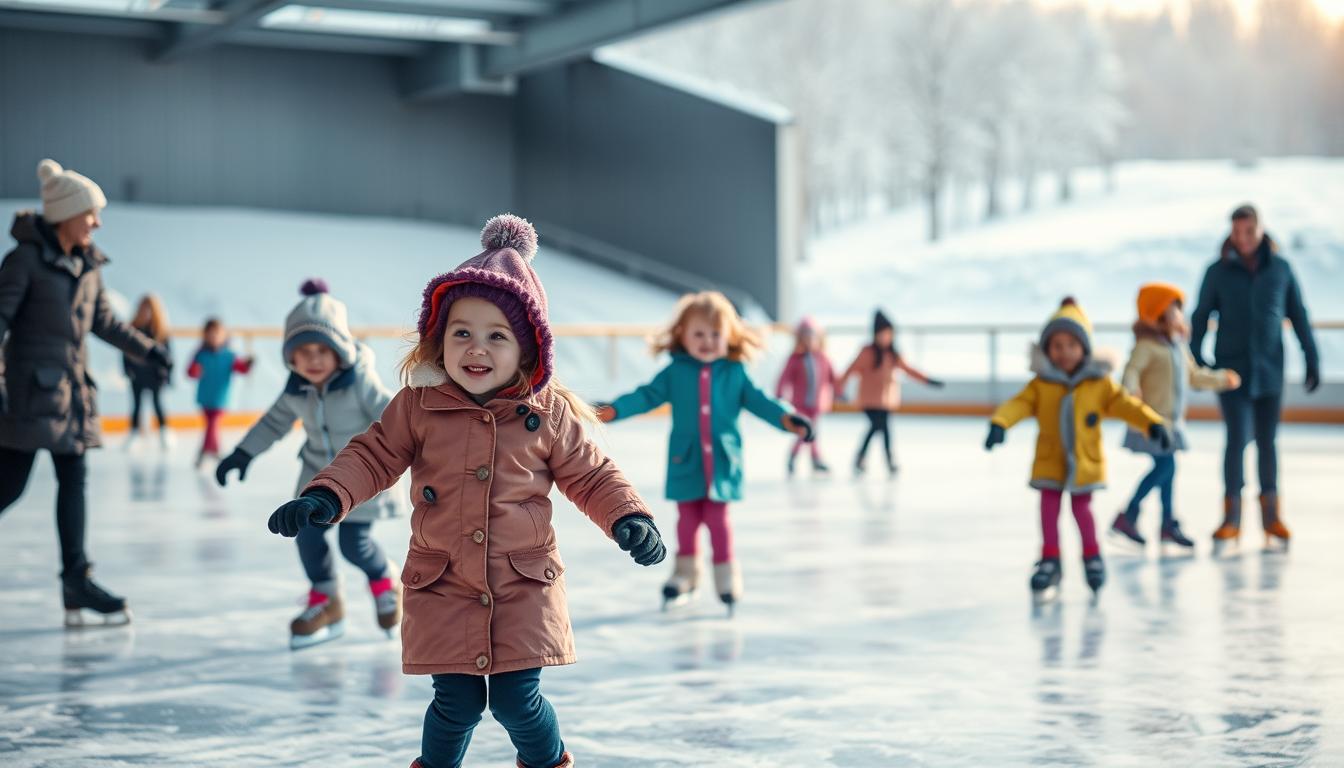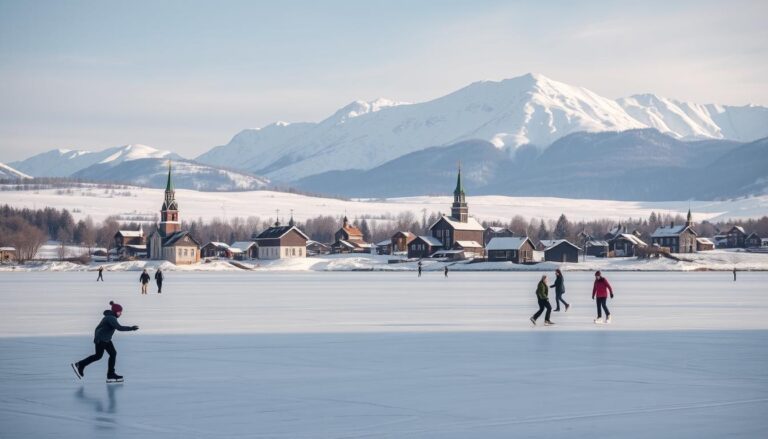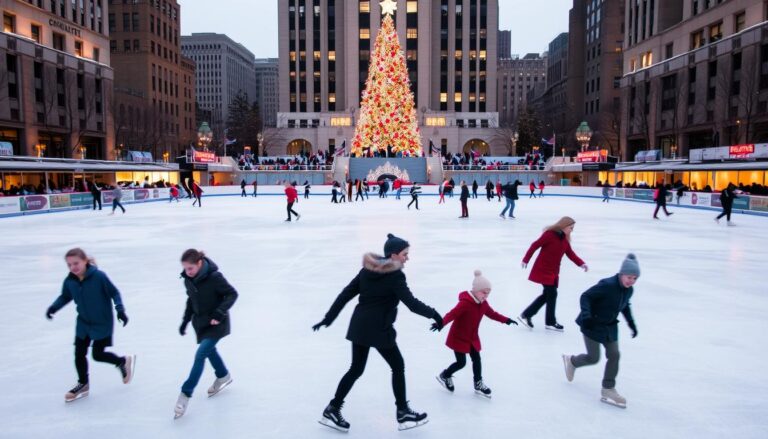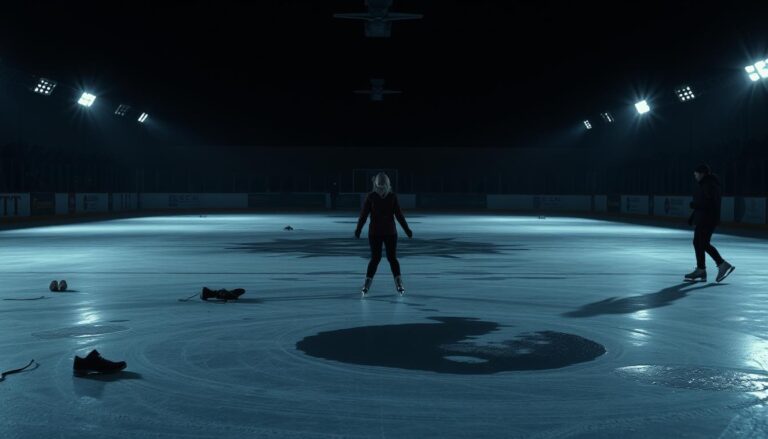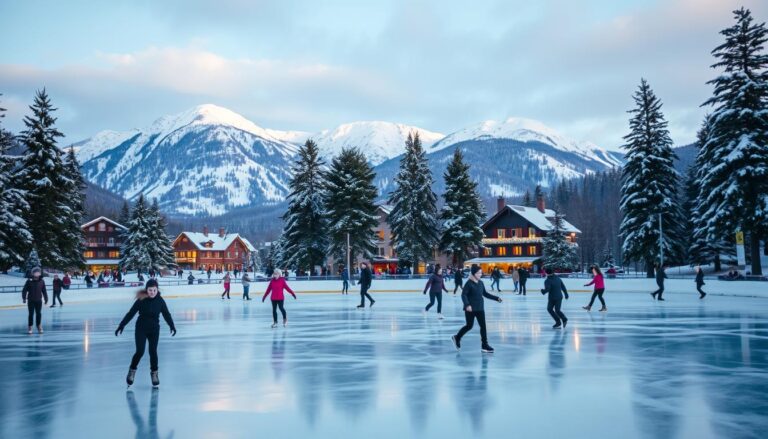The Best Age For Kids to Start Ice Skating Is 3-5 Years Old
Introducing your child to ice skating at the right time can be very rewarding. Experts agree that kids aged 3-5 are the best to start. This age range offers a perfect mix of physical and mental readiness.
Children at this age have the right balance of strength and agility. Their growing bodies and minds make learning to skate both fun and easy. It’s a great way to help them develop their skills.
Experts say that kids aged 3-5 have a big advantage when it comes to ice skating. Their brains are more flexible, making it easier to pick up new skills. This age is perfect for learning how to skate.
Young children are also very good at picking up new movements. Their lower center of gravity helps them stay balanced. This makes ice skating a great way to improve their athletic abilities.
At this age, kids can also understand and follow simple instructions. They can learn basic safety rules and stay focused during lessons. This makes them ready for structured skating lessons.
Skating instructors suggest starting with fun, easy lessons. These short sessions help kids feel confident and excited about skating. It’s a great way to make learning fun.
When deciding when to start ice skating, consider your child’s readiness. Every child is different, but 3-5 years is usually the best time. It’s a period when they can learn and enjoy skating the most.
Starting ice skating at this age can give your child many benefits. They’ll develop athletic skills, gain confidence, and make happy memories. It’s a great way to support their growth and development.
Understanding the Ideal Age Window for Ice Skating
Finding the right age to start ice skating is key for young kids. The 3-5 year range is perfect for starting, thanks to important growth stages. These stages make learning ice skating fun and easy.
Children aged 3-5 are naturally good at ice skating. Their bodies are flexible and balanced, helping them stay steady on the ice.
Physical Development Markers
During this time, kids grow fast, helping their ice skating skills:
- Improved muscle strength and control
- Enhanced body awareness
- Increased ability to follow simple instructions
- Natural curiosity and willingness to learn
Motor Skill Requirements
The best age to start ice skating matches kids’ motor skill growth. At this stage, kids can:
- Maintain basic standing balance
- Follow directional commands
- Coordinate multiple body movements
- Demonstrate basic spatial awareness
Balance and Coordination Factors
Kids aged 3-5 grow fast in balance and coordination. Their neural pathways are developing rapidly. It’s the best time to start ice skating.
Knowing these milestones helps parents support their kids in ice skating. It’s a critical learning period.
When Can Kids Start Ice Skating: Expert Recommendations
Skating coaches and child experts say kids can start ice skating between 3-5 years old. This age is perfect for kids to learn important motor skills and feel confident on the ice.
Experts say there are a few things to think about before kids start ice skating:
- Physical coordination and balance
- Muscle strength and control
- Attention span and ability to follow instructions
- Interest in learning a new skill
Dr. Sarah Reynolds, a pediatric sports medicine specialist, says kids around 4-5 years old are ready to start ice skating. At this age, they can:
- Understand basic safety instructions
- Maintain balance with minimal support
- Follow simple skating techniques
Pro tip: Every child develops differently, so individual readiness may vary. Always consult with a professional skating instructor to assess your child’s specific capabilities.
Parents should make learning to ice skate fun and supportive. Coaches suggest starting with group lessons for young kids. These lessons help build skills and confidence together.
Benefits of Starting Ice Skating Between Ages 3-5
Introducing kids to ice skating early opens up a world of opportunities. Starting between 3-5 years old offers physical, cognitive, and social benefits. These benefits can shape a child’s growth in amazing ways.
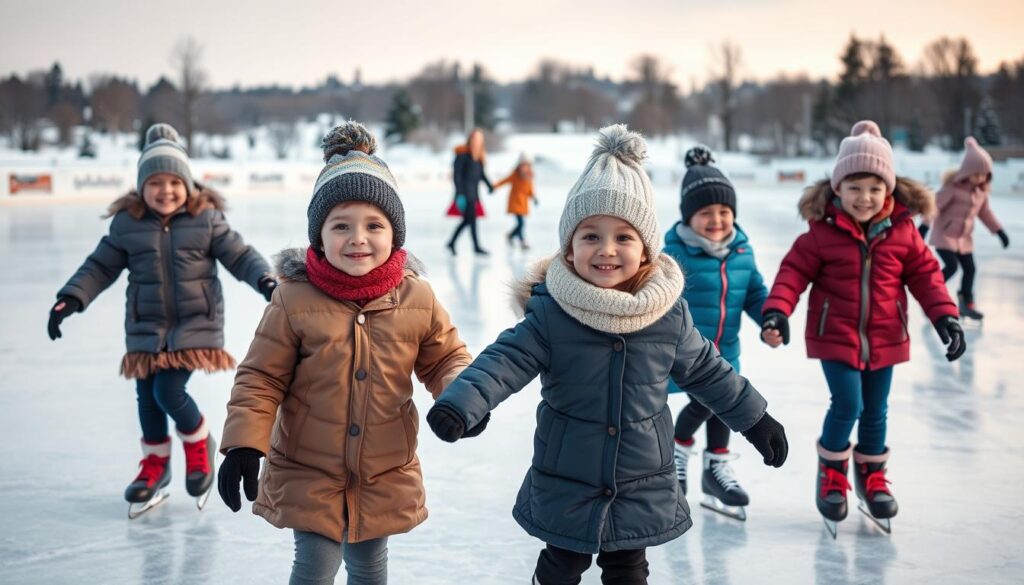
Physical Benefits That Spark Lifelong Fitness
The right age to start ice skating is key for kids. Early skating experiences bring many physical advantages:
- Builds core strength and muscle development
- Improves overall balance and coordination
- Enhances flexibility and body awareness
- Develops cardiovascular endurance
Cognitive Development Advantages
Ice skating challenges young minds in special ways. Kids learn complex motor skills that boost brain development, including:
- Spatial awareness and problem-solving
- Concentration and focus
- Decision-making under dynamic conditions
- Improved mental processing speed
Social Skills Enhancement
Ice skating also boosts social skills. Group lessons and rink interactions help kids:
- Build confidence in social settings
- Learn teamwork and cooperation
- Develop communication skills
- Create lasting friendships
The magic of starting ice skating as a child lies in its holistic approach to development. By introducing children to this exciting sport between ages 3-5, parents can unlock a world of opportunity that goes beyond the ice.
Safety Considerations for Young Ice Skaters
When kids start ice skating between ages 3-5, safety is key for parents. Knowing the right safety steps makes ice skating fun and safe for little ones.
Wearing the right gear is vital to avoid injuries on the ice. The right equipment helps kids learn to skate safely.
- Helmets are a must for young skaters
- Padded gear for knees and elbows
- Ice skates that fit well and support ankles
- Clothes that are warm and let kids move freely
It’s important to watch over kids when they start ice skating. They should be with a trained teacher or a parent who knows how to help.
Being safe at the rink is more than just wearing gear. Kids need to know how to act on the ice:
- Be aware of others around you
- Know how to stop safely
- Skate in the same direction as others
- Move to the side if you need to rest
Pro tip: Start with lessons in a controlled environment with professional instructors who specialize in teaching young children the fundamentals of ice skating safely.
Essential Equipment for Beginning Child Skaters
Getting your child ready for ice skating is more than just excitement. The right gear makes the experience magical for young ones. When kids start skating, the right equipment is key for safety and comfort.
Choosing the right gear for your young skater is important. From skates to protective gear, each item is vital for a good skating experience.
Proper Skate Fitting
Finding the right skates is essential for young skaters. Here are some key fitting tips:
- Ensure snug but not tight fit around the ankle
- Allow minimal heel movement inside the boot
- Check for proper arch support
- Consider adjustable skates for growing children
Protective Gear Requirements
Safety is the top priority when kids start ice skating. Protective gear builds confidence and prevents injuries.
| Protective Item | Purpose | Recommended Age |
|---|---|---|
| Helmet | Head protection | 3-8 years |
| Knee Pads | Joint protection | 3-6 years |
| Wrist Guards | Prevent wrist injuries | 4-7 years |
| Padded Shorts | Hip and tailbone protection | 3-5 years |
Clothing Recommendations
Dressing your child for ice skating needs careful thought. Comfort and mobility are important when picking skating clothes.
- Wear moisture-wicking base layers
- Choose flexible, warm mid-layers
- Select lightweight, water-resistant outer layers
- Opt for warm, thin socks
The right equipment makes ice skating fun and safe for kids. It’s important for their skating journey.
Signs Your Child Is Ready for Ice Skating

Figuring out when kids can start ice skating is important. It depends on their physical and emotional readiness. Most children between 3-5 years old can start skating with the right preparation.
Seeing if your child is ready involves looking at several signs. Here are key signs that show your child might be ready to skate:
- Demonstrates good balance while walking and running
- Shows curiosity about physical activities
- Can follow simple instructions
- Displays enthusiasm for trying new experiences
- Has developed basic motor coordination
Physical skills are key for skating readiness. Kids need enough strength to stand and some core stability. Emotional readiness is also important. Your child should be excited, not scared, about skating.
| Readiness Indicator | Age Range | Significance |
|---|---|---|
| Motor Skill Development | 3-5 years | Essential for basic skating movements |
| Attention Span | 4-5 years | Can focus during brief instructions |
| Physical Strength | 3-4 years | Ability to maintain balance |
Remember, every child develops differently. Some might be ready earlier, while others may need more time to feel comfortable on the ice. Patience and positive encouragement are key to introducing your child to the exciting world of ice skating.
Common Challenges When Teaching Young Children to Skate
Starting ice skating as a child is both exciting and challenging. Parents and instructors face specific hurdles when teaching young ones. Knowing these challenges helps create a supportive learning space.
Introducing kids to ice skating usually happens between 3-5 years old. This age range comes with unique challenges that need patience and a strategic approach.
Managing Childhood Fears on Ice
Young skaters often feel fear on the slippery ice. They worry about falling or losing balance. To help, try these strategies:
- Make the learning environment supportive and low-pressure.
- Use positive reinforcement to boost confidence.
- Show enthusiasm when demonstrating skating techniques.
- Let children progress at their own pace.
Addressing Balance Challenges
Young children are developing their motor skills, affecting their skating. Balance is key when gliding on ice.
| Age Group | Balance Development | Recommended Support |
|---|---|---|
| 3-4 years | Minimal balance control | Constant physical support |
| 4-5 years | Improving coordination | Gentle guidance, skating aids |
| 5-6 years | Enhanced motor skills | Minimal assistance |
Navigating Short Attention Spans
Young skaters often find it hard to focus. Short, fun, and engaging lessons are essential to keep them interested. Use games and breaks to keep them motivated.
By tackling these challenges, parents can help their kids build confidence and skills on the ice. This turns learning into a fun experience.
First Lesson Preparation Tips
Getting ready for your child’s first ice skating lesson is both thrilling and a bit scary. When kids start ice skating between ages 3-5, it’s important to prepare well. Knowing when kids can start ice skating helps parents set up the best first lesson.
Before you go to the rink, make sure you have everything your child needs:
- Warm, layered clothing
- Thick wool socks
- Comfortable, well-fitting skates
- Helmet for protection
- Water bottle
- Extra pair of mittens
It’s also key to mentally prepare your child for ice skating. Talk about the lesson in a positive way, and reassure them that falling is okay. It’s a part of learning. You can also watch beginner skating videos or read books about ice skating together.
Here are some practical tips for the first lesson:
- Arrive 30 minutes early to get comfortable with the environment
- Dress in comfortable, flexible clothing
- Pack a small snack for energy
- Bring a positive, encouraging attitude
Every child learns at their own pace. Some might pick it up quickly, while others need more time. Patience and encouragement are key to helping young skaters feel confident on the ice.
Choosing the Right Ice Skating Program for Your Child
Finding the perfect ice skating program for kids can be tricky. Parents need a clear plan to pick the best place for their young ones to learn. This is key for a great start in ice skating.
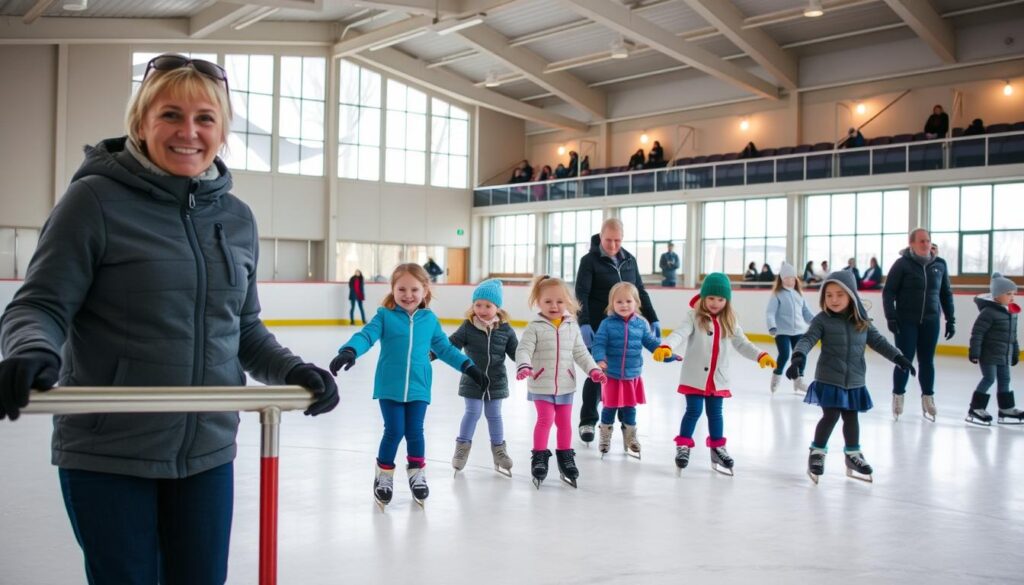
When looking for ice skating programs for kids aged 3-5, several important factors come into play. The right program can make your child’s first skating experience exciting and inspiring.
Exploring Lesson Formats
There are two main types of lessons for young skaters:
- Group Lessons
- More affordable option
- Social interaction opportunities
- Structured learning environment
- Private Lessons
- Personalized attention
- Faster skill progression
- Customized learning pace
Instructor Qualifications to Consider
| Qualification | Importance | What to Look For |
|---|---|---|
| Certification | High | U.S. Figure Skating Association credentials |
| Experience | Critical | Minimum 3-5 years teaching young children |
| Background Check | Essential | Current child safety certification |
Pro tip: Always request a trial lesson to assess the instructor’s compatibility with your child’s learning style and personality.
Choosing the right ice skating program is important. Look for qualified instructors, the right lesson format, and consider your child’s needs. This will help ensure a fun and rewarding skating experience for them.
Progress Expectations for Different Age Groups
Knowing how young skaters progress helps parents set realistic goals. Kids between 3-5 years old learn at their own pace. So, it’s all about their individual growth.
When deciding if it’s safe for kids to start ice skating, look at these age milestones:
- Age 3: Basic balance and movement
- Age 4: Improved coordination and directional control
- Age 5: Enhanced gliding and introductory stopping techniques
Young skaters usually go through these steps:
- Learning to stand on ice by themselves
- Taking first steps with help
- Feeling confident without support
- Mastering basic forward movement
Pro tip: Every child’s skating journey is unique. Patience and consistent encouragement are key to building skating confidence.
Parents should focus on fun, not just performance. Celebrating small wins keeps kids excited and helps them improve their ice skating skills.
Building Confidence On Ice: Techniques and Strategies
Starting ice skating as a child is more than just physical skills. It also needs emotional support and creative learning. Confidence on the ice grows with games, support, and positive feedback that make skating fun for kids.
The best time for kids to start ice skating is between 3-5 years old. This age is key for learning motor skills and gaining confidence. At this time, kids are eager to learn new things with the right help.
Fun Learning Games
Games make skating practice fun and exciting. Here are some great activities:
- Penguin Waddle: Encourage children to walk like penguins to improve balance
- Freeze Dance: Play music and have kids stop when it pauses, improving control
- Follow the Leader: Create simple skating paths for children to mimic
- Treasure Hunt: Place colorful markers for kids to skate toward
Positive Reinforcement Techniques
Building a young skater’s confidence needs emotional support:
| Technique | Impact |
|---|---|
| Verbal Praise | Immediate encouragement after attempts |
| Small Rewards | Stickers or special privileges for progress |
| Patient Instruction | Calm, supportive teaching approach |
Remember, every small victory counts when introducing children to ice skating. The goal is to create a fun, supportive environment that nurtures their natural curiosity and builds lasting skills.
Important Milestones in Early Ice Skating Development

Introducing kids to ice skating is an exciting journey. Children usually start between ages 3-5. They learn skills that boost their confidence and physical abilities.
The early skating journey has several key achievements. Parents can look forward to these milestones:
- First Stable Standing (3-4 years): Learning to balance on ice skates
- Initial Gliding (4-5 years): Moving short distances independently
- Basic Stopping Techniques (5-6 years): Mastering fundamental safety skills
- Directional Control (5-6 years): Turning and changing directions
Knowing when kids can start ice skating helps set realistic goals. Young skaters progress at their own pace, based on their coordination and comfort.
| Age Range | Skating Milestone |
|---|---|
| 3-4 years | Balance and Basic Stance |
| 4-5 years | Short Glides and Movement |
| 5-6 years | Controlled Turns and Stops |
Each milestone is a big achievement in a child’s ice skating journey. Patience and consistent practice are essential. They help young skaters build skills and confidence on the ice.
How Parents Can Support Their Young Skater
Supporting your child’s ice skating journey needs patience, enthusiasm, and smart guidance. When kids start ice skating between ages 3-5, your help is key. It helps them enjoy and grow in the sport.
As a supportive parent, make a positive and encouraging space. Knowing the right ice skating age for kids helps you set the right goals. This way, you can offer the right support.
- Create a fun, pressure-free atmosphere
- Celebrate small victories and progress
- Listen to your child’s feelings about skating
- Provide consistent emotional encouragement
Talking to skating instructors is important. Ask about your child’s progress, challenges, and best practice tips. This helps you know how to help them improve, both on and off the ice.
Practical support includes:
- Investing in proper skating equipment
- Attending lessons regularly
- Practicing gentle at-home balance exercises
- Maintaining a positive attitude toward learning
Remember, every child learns differently. Your unconditional support can turn their skating journey into an exciting adventure.
Long-term Benefits of Early Ice Skating Introduction
Starting ice skating at the right age can open a world of benefits for kids. The age of 3-5 is key for developing skills that last a lifetime.
Early skating helps kids grow physically. They develop skills that help them throughout their lives.
Physical Development Milestones
- Enhanced muscle strength and flexibility
- Improved balance and coordination
- Better overall body awareness
- Increased cardiovascular endurance
Mental Health and Cognitive Advantages
Ice skating has big mental health benefits for kids. It helps them grow emotionally and mentally. Learning to skate teaches important life skills.
- Boosts self-confidence
- Develops resilience through overcoming challenges
- Enhances focus and concentration
- Provides stress relief through physical activity
Early ice skating sets a foundation for lifelong fitness and mental health. It turns first steps into a journey of growth and success.
Conclusion
Learning when kids can start ice skating opens a world of fun for them. The ages 3-5 are perfect for ice skating because kids are growing and learning fast. Parents can start their kids on this exciting sport with confidence.
It’s not just about being ready physically to ice skate. It’s also about making a safe and fun place for kids to learn. Every child’s skating path is unique, filled with special moments and achievements.
Starting to skate is all about taking it slow, being patient, and encouraging kids. By making it fun and safe, parents can help kids love ice skating for life. Every step on the ice is a chance for kids to learn and grow.
Enjoy the journey of watching your child learn to skate. See their confidence grow with each try. Your support and excitement will be the biggest help in their skating adventure.
